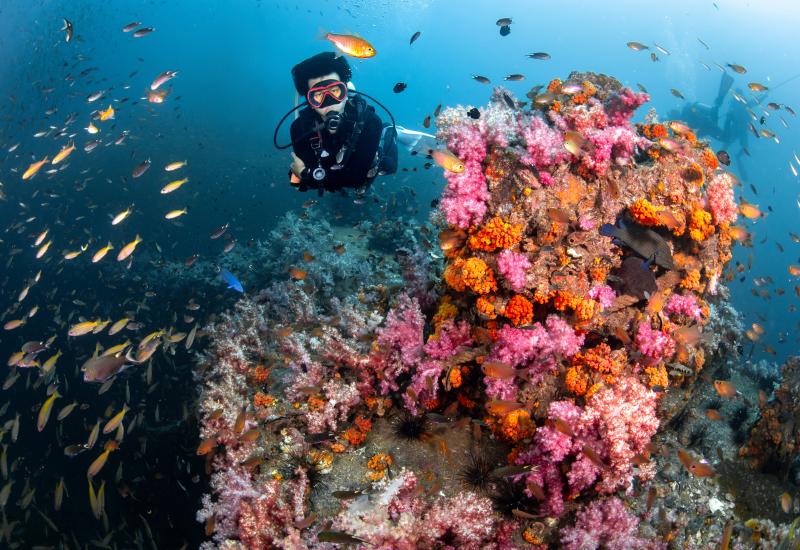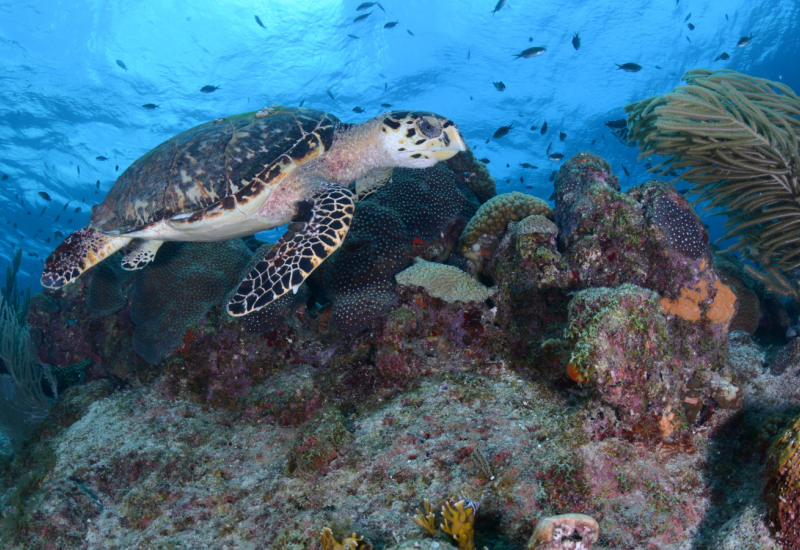11 Awesome Big-Animal Encounters for Advanced Scuba Divers
Pack your scuba gear and get ready for big-animal diving unlike anything you've ever seen. From shark diving in Fiji, the Galapagos Islands, the Red Sea and the Azores to up-close encounters with humboldt squid in the Sea of Cortez, these bucket-list dives will test your skills and boost your adrenaline — but they are well worth the reward.

Gerald NowakA nerpa seal swims in Lake Baikal, which is the only place in the world where these marine mammals live.
NERPA SEALS | LAKE BAIKAL, RUSSIA
No one says getting to Siberia is easy. But Russia’s remote World Heritage-listed Lake Baikal is the only place in the world where you can dive with nerpa seals. Endemic to this one particular lake, they are an earless species related to Arctic ring seals and among the only freshwater seals in the world. Nerpas can weigh up to 260 pounds, and like other seals are underwater acrobats, diving to depths of more than 1,000 feet. They spend most of the winter under the ice or in snowy lairs topside. And while ice diving is one way to see them, we advise waiting for the summer thaw to enjoy Siberia’s fabulous hiking too.
Dive Conditions: 54°F water temperature in summer, 130 feet average visibility
Dive Now: Baikal Diving
NARWHALS | NUNAVUT, CANADA
Often called the unicorn of the sea, the narwhal is known for a spiraling, swordlike protuberance from its head that’s actually an erupted tooth rather than a horn. Entering the water in Arctic Canada with these fantastical creatures is inspiring. During May and June, you’ll gear up in your drysuit atop landfast ice miles out to sea, then plunge in at the floe edge. “You can hear them loud and clear as they vocalize,” says Jason Hillier of Arctic Kingdom. “They are like underwater acrobats, and the younger whales seem to truly enjoy checking us out.”
Dive Conditions: 29°F water temperature, 80 feet average visibility
Dive Now: Arctic Kingdom

Greg LecoeurExperience the legendary South Africa Sardine Run and dive alongside dolphins during the most amazing feeding frenzy in the world.
DOLPHINS | SOUTH AFRICA
Catching the legendary Sardine Run when it’s doing its thing is like witnessing an underwater Serengeti. From May through July off South Africa’s east coast, billions of northbound sardines are fodder for an all-out frenzy that lures whales, sharks, diving gannets and dolphins. Common and bottlenose dolphins are the primary herders, working in teams to corral the sardines. With an estimated 18,000 dolphins following the Sardine Run, this is one of the most reliable places in the world to see them.
Dive Conditions: 62°F water temperature, 20 feet average visibility, strong currents possible
Dive Now: Blue Ocean Dive Resort
HUMBOLDT SQUID | SEA OF CORTEZ, MEXICO
In-water encounters with aggressive Humboldt and giant squids are very rare and only for very serious (or crazy) adventurers. But just seeing the creature jigged up on deck during liveaboard trips in the Sea of Cortez is a thrill. “Our clients say it’s the most alien thing they’ve witnessed — like seeing a creature from outer space,” says Rocio del Mar owner Dora Sandoval. At night, dive guides jig up the squid — some specimens up to 6 feet long — using lights to attract them in the deep waters where sperm whales, which are the squids’ main predator, are seen during the day. “They get pretty aggressive and excited,” says Sandoval of the squid, which are voracious eaters and often engage in cannibalization as they’re being reeled in.
Dive Conditions: 65°F-85°F water temperature, 60 feet average visibility
Dive Now: Rocio del Mar

Jordia ChiasDiving with blue sharks in the Azores is a baited shark encounter that you won't want to miss.
BLUE SHARKS | AZORES
Operators use pulverized sardine and mackerel to attract blue sharks in the Atlantic waters off the remote Azores. Back-roll off the Zodiac and drop down a line to wait for the show. Most of the blues are in the 6-foot range, but their attitude makes up for what they lack in size. “Showing no signs of stress, they roam the water around the boat and the bait box, and come over to the lines for a closer look at the bubbling visitors,” says German photographer Daniel Brinckmann. “Don’t be surprised if one gives your strobes a little toothy treatment.”
Dive Conditions: 71°F water temperature, 60 feet average visibility
Dive Now: Norberto Diver
TIGER SHARKS | BEQA LAGOON, FIJI
“Set your lens and strobes wide, and don’t turn into a dribbling pile of sissy,” says underwater photographer Jeffrey Millisen of photographing tiger sharks. At Tiger Shark Cathedral, off Beqa, Fiji, the striped beauties are lured by a feeding box near a wall that drops to 70 feet. As many as seven tigers show up on a single frenetic dive.
Requirements: Must have at least 30 logged dives
Dive Conditions: 79°F water temperature, 90 feet average visibility
Dive Now: Beqa Lagoon Resort
OCEANIC WHITETIP SHARKS | RED SEA, EGYPT
With aquariumlike visibility and some of the most beautiful soft coral gardens in the world, the Red Sea’s dive sites are a world apart. Trips on the Red Sea Aggressor that depart from southern Egypt are a safe way to visit the area to get up close with some of the most exciting sharks in the ocean. Oceanic whitetips are reliably seen around the pelagic-magnet pinnacles of Daedalus Reef, Brother Islands and Elphinstone from October through December. “The sharks gather in 15 to 20 feet of water under the liveaboards and make repeated passes at any divers lucky enough to share the water,” says Sport Diver EMEA editor Mark Evans. “They can become rather frisky, but shark aficionados and underwater photographers will be in their element.”
Dive Conditions: 74°F water temperature, 100 feet average visibility
Dive Now: Red Sea Aggressor Liveaboard
SCALLOPED HAMMERHEADS | GALAPAGOS ISLANDS, ECUADOR
Of the endless Darwinian reasons to visit the Galapagos in the eastern Pacific Ocean, the chance to fin among schooling scalloped hammerheads is near the top of every diver’s list. Though hammers can be spotted throughout the archipelago, Darwin and Wolf islands — accessible only by liveaboard — are the best spots to encounter them. June brings massive migrations, with the animals often numbering in the thousands. Wayne B. Brown, CEO of Aggressor Fleet, remembers his first time in the water with these unique sharks: “There was a virtual wall of them, from as far deep and as high as I could see,” he says. “To see them in person — what I had previously seen only on TV and in magazines — was the ultimate justification of why I started diving.”
Dive Conditions: 79°F water temperature, 90 feet average visibility
Dive Now: Galapagos Aggressor III Liveaboard
THRESHER SHARKS | MALAPASCUA, PHILIPPINES
You likely won’t mistake a thresher shark for anything else. The scythelike tail that commands almost half of its torpedolike body and can alone weigh more than 700 pounds gives this animal an unmistakable look. That they use those tails S&M-style to stun or kill prey makes them all the more fascinating and intimidating. Threshers exist in all of the world’s tropical oceans. But for the most reliable sightings, Malapascua — a tiny island off the northern tip of Cebu in the Philippines — is the spot. Cleaning stations at the dive site called Monad Shoal are magnets for one of the toothiest and tailsome shows of your life.
Dive Conditions: 84°F water temperature, 65 feet average visibility, strong currents possible
Dive Now: Sea Explorers

David B. Fleetham/SeapicsDive with a giant Pacific Octopus in Vancouver Island, British Columbia, Canada.
GIANT PACIFIC OCTOPUS | VANCOUVER ISLAND, BRITISH COLUMBIA
Forget all you know about mini Caribbean octopuses. The bracing waters off Vancouver Island set the stage for an octopus encounter on an entirely different scale. The intelligent giant Pacific octopus is the largest of all octopuses, averaging 16 feet across and weighing around 110 pounds. They blend with their surroundings and live in large dens or caves, but they can be spotted in open areas too. Color changes give insight into their moods. “White indicates fright, bright red is anger, and a dull brick-red octopus is tired as well as angry,” says Washington diver Mike Reynolds, who was once approached from behind by a bright-red specimen (he managed to free himself thanks to loose rocks preventing the octopus from gaining a hold).
Dive Conditions: 57°F water temperature, 35 feet average visibility
Dive Now: God’s Pocket Resort
NAPOLEON WRASSE | PALAU
Also known as humphead and Maori wrasse — a reference to the intricate patterning around their heads that resembles tribal tattoos — Napoleon wrasse are one of the most outgoing and friendly creatures you’ll encounter in the Indo-Pacific region. The largest of wrasses are among the world’s biggest reef fish too; they weigh up to 400 pounds and could easily blanket your car’s windshield. Napoleons have a curious streak that endears them to divers. At iconic Palau sites such as Blue Corner and Peleliu Express, divers are approached by puppylike Napoleons that seem to be soliciting a pat on the flank.
Dive Conditions: 82°F water temperature, 82 feet average visibility
Dive Now: Sam’s Tours Palau
Want more? Check out the best places to freedive and snorkel with humpback whales, belugas, sailfish and more big animals.










